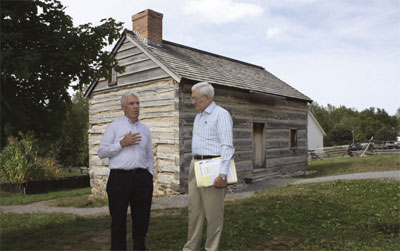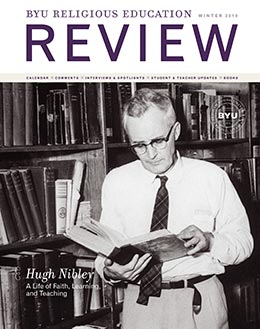Scott C. Esplin (scott_esplin@byu.edu) was an assistant professor of Church history and doctrine at BYU when this was published.

Teaching the gospel of Jesus Christ, faculty members in Religious Education enjoy the opportunity to walk students figuratively across the sacred ground of scripture. However, literally studying on-site can bring additional power. “Inspiration comes easier,” President Boyd K. Packer counseled BYU faculty, “when you can set foot on the site.”[1] Because of the increased blessing for teaching and scholarship associated with on-site experience, Religious Education has long ties to studying the sacred ground of the Restoration.
The fall 2009 issue of the BYU Religious Education Review highlighted the work of Daniel H. Ludlow in taking the first group of BYU students to the Holy Land as well as Larry C. Porter and Richard L. Anderson’s contributions to locating the sites for the reconstructed Joseph Smith Sr. and Peter Whitmer Sr. log homes in New York. While these and other faculty members have contributed greatly to the on-site experience for thousands of Church members who annually retrace sacred steps, other Religious Education endeavors contribute to scholarly understanding of historic sites. One program nearly twenty-five years in operation has aided the study of Church history worldwide. Inaugurated in 1985, the Regional Studies in Latter-day Saint Church History series has produced fifteen volumes analyzing the history of the Church in New England, New York, Pennsylvania, Ohio, Missouri, Illinois, Arizona, California, Canada, Great Britain, Europe, and the Pacific Isles. Focusing regionally, the scholarship explores topics from the early Restoration through current issues related to an international church. Each regional study, currently conducted biennially, includes academic research on the chosen location, coupled with scholarly presentations and site visits.
The idea for research and travel to historic sites originated with Keith W. Perkins, former chair of the Department of Church History and Doctrine. As the childhood home of Joseph Smith, New England was selected for the initial symposium in the summer of 1985 because “it is the birthplace and seedbed of Mormonism.”[2] Following completion of their research, participants in the original study reflected on the experience, noting that “future teaching concerning the Saints, the Macks, the Smiths, and New England would never again be the same [because] people, places and events in New England were now a living part of their consciousness.”[3]
Subsequent studies continued the focus on sites significant to both the early and modern Church including Arizona (1986), New York (1988, 1999), Ohio (1989, 2004), Missouri (1991), Illinois (1993), and Pennsylvania (1999). Later editions coincided with sesquicentennial celebrations of the Church in Great Britain (1987), California (1996), and continental Europe (2000) or shined a historical light on Church growth in international regions like Western Canada (1998), Upper Canada (2004), and the Pacific Isles (2008). Visits to each region included interactions with members, leaders, and local historians. Overall, the program has amassed a significant body of scholarly work on historic Church sites, including more than 175 articles devoted to the regional themes.
Editors for the 1988 New York symposium summarized the impact of these studies. “For the historian,” Larry C. Porter, Milton V. Backman Jr., and Susan Easton Black wrote, “there is little that can compensate for standing on the ground where events transpired. Even with the many changes that have come through the years, there is a particular sense of physical direction, setting, and certainly a feel for the historical events themselves which can be recreated, if only in part, by being on-site.”[4] The Regional Studies series has “increased our ability as teachers to illustrate more accurately the historical and spiritual legacy of The Church of Jesus Christ of Latter-day Saints.”[5]
Notes
[1] Boyd K. Packer, “The Snow-White Birds,” BYU, Annual University Conference, 1995.
[2] Donald Q. Cannon, ed., Regional Studies in Latter-day Saint Church History: New England (Provo, UT: Department of Church History and Doctrine, Brigham Young University, 1988), v.
[3] Cannon, New England, v.
[4] Larry C. Porter, Milton V. Backman Jr., and Susan Easton Black, eds., Regional Studies in Latter-day Saint Church History: New York (Provo, UT: Department of Church History and Doctrine, Brigham Young University, 1988), ix.
[5] Porter, Backman, and Black, New York, ix.
